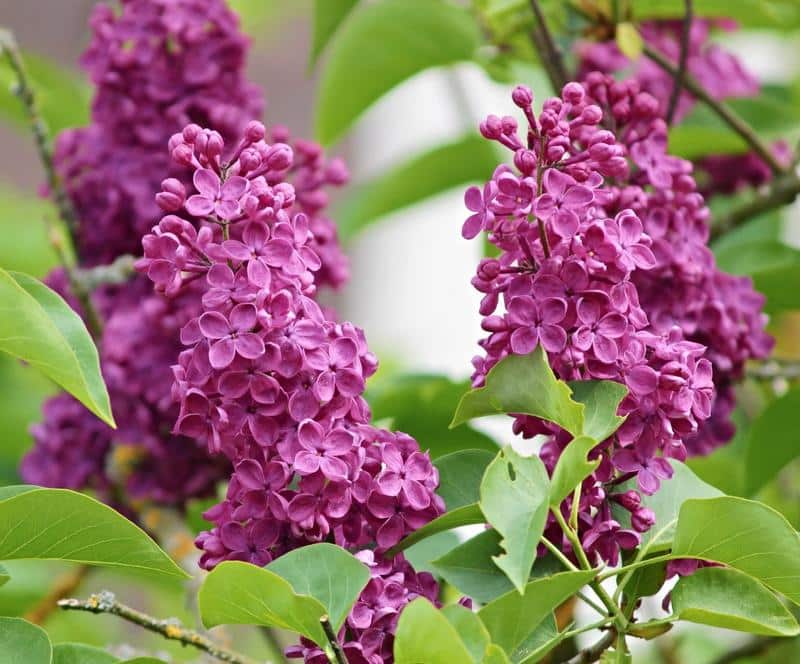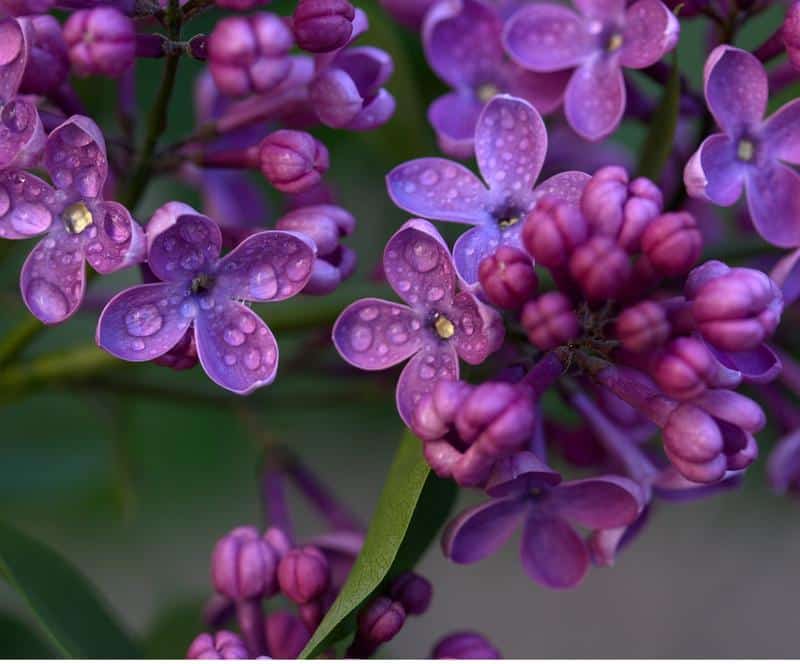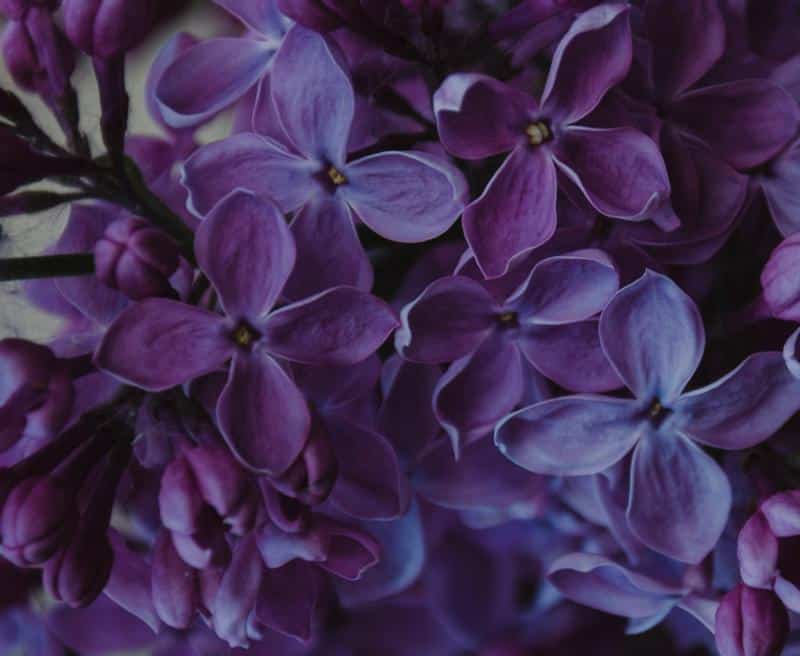Are Lilacs Poisonous to Dogs? Are Lilacs Toxic to Dogs?
Are lilacs poisonous to dogs? Are lilacs toxic to dogs? In this article, we’ll teach you everything you need to know including if lilacs are safe for dogs to eat, and what you should do if they already have. We’re then going to train you on the two commands that will ensure your dog stays away from lilacs and other plants.
Next, we’ll cover more you should know about lilacs and dogs, such as how to keep dogs away from lilacs so they can grow to be beautiful. Finally, we’ll wrap all of this up by instructing you on how to grow lilacs when you have dogs around. Keep reading!
Are Lilacs Poisonous to Dogs?

Lilacs are not poisonous to dogs. These fragrant flowers, known scientifically as Syringa, are considered non-toxic to dogs. However, as with any non-food plant, it’s always a good idea to discourage dogs from eating lilacs as they could cause minor gastrointestinal upset if ingested in large quantities.
Are Lilacs Toxic to Dogs?
Lilacs are not toxic to dogs. This includes the entire lilac plant, from its flowers to its leaves. However, ingesting large amounts of any plant material can lead to minor discomfort in dogs, including vomiting or diarrhea.
While it’s generally safe for dogs to be around lilacs, it’s best to discourage them from eating any part of this or any other plant.
Is Lilac Smell Toxic to Dogs?
The lilac smell is not toxic to dogs. Canines have a much stronger sense of smell than humans, and while some dogs may enjoy the smell of lilacs, others might not. However, it’s important to note that artificial lilac scents, such as those found in some perfumes or air fresheners, could potentially be irritating to a dog’s respiratory system.
Training the “Leave It” Command
Training your dog to follow the “Leave It” command can be an effective way to prevent them from ingesting non-food items, such as lilacs. This command tells your dog to stop what they’re doing and move their attention away from whatever they’re focused on.
- Show your dog a treat in your hand and say “Leave It”.
- When your dog stops trying to get the treat, reward them with another treat from your other hand.
- Gradually increase the duration before you give the reward.
- Practice this command with different items and in different locations.
Training the “Drop It” Command
Similarly, the “Drop It” command instructs your dog to let go of an item they’ve picked up in their mouth. This can be especially useful if your dog manages to pick up a part of a lilac plant or any other non-food item.
- Play a game of fetch with your dog using a toy.
- When your dog has the toy in their mouth, say “Drop It” clearly and firmly.
- Reward your dog with a treat or praise when they drop the toy.
- Repeat this until your dog consistently drops the toy when commanded. Then practice with various items.
These steps will get your dog to stop eating lilacs, but it’s important to remember that the underlying behavioral issues (curiosity, anxiety, boredom, etc.) that were causing all of this to begin with will still be present. And until you address those, any positive changes you see are only going to be temporary.
“Well, how do I make these changes last?”
By getting your dog to truly choose to follow your direction, that’s how. I tried many times to write out how you can do that before deciding it made more sense to just link you to the free video series that explains it better than I’d ever be able to.
The series is by a man named Dan who is one of the world’s leading dog obedience trainers. In it, he teaches you how to put an end to things like your dog eating lilacs and all other misbehavior using his fast and easy-to-follow methods.
In the first video, Dan will reveal to you why the two most common methods of dog training only doom you to failure. You can watch the video now by clicking here. Follow the proven system he’ll show you in his series and you’ll never have to spend another second worrying about your dog eating a lilac ever again!
Are Lilacs Safe for Dogs to Eat?

Lilacs are not toxic to dogs, but they’re not a food source and shouldn’t be eaten by dogs. If consumed in large amounts, lilacs, like any non-food plant material, can potentially cause minor gastrointestinal upset in dogs.
Can Dogs Eat Lilacs?
While lilacs are not toxic to dogs, it’s important to remember that they are not part of a dog’s typical diet. Even though they are non-toxic, ingesting lilacs or any non-food plant can potentially lead to minor gastrointestinal issues such as vomiting or diarrhea. Therefore, it’s best to prevent your dog from eating lilacs or any other non-food plants.
My Dog Ate a Lilac, What Do I Do?
If your dog ate a lilac, don’t panic. While it’s not ideal, ingesting a lilac is unlikely to cause serious harm. Monitor your dog closely for any signs of distress, such as vomiting, excessive drooling, or loss of appetite. If your dog exhibits any of these signs, or if they seem unwell, contact your vet immediately.
Dog Eating Lilacs: Prevention Tips
Prevention is key when it comes to stopping dogs from eating lilacs or any other non-food plants. Here are some tips to discourage this behavior:
- Keep an eye on your dog when they’re in an area with lilacs or other plants.
- Use a lead or leash if your dog has a habit of eating non-food items during walks or outdoor play sessions.
- Train your dog to understand commands such as “Leave it” and “Drop it”. Learn both in the first section. These commands can help prevent your dog from picking up and eating non-food items.
While lilacs are not toxic to dogs, they’re not safe for dogs to eat due to the potential for minor gastrointestinal upset. Always prevent your dog from eating lilacs or other non-food plants. Use effective commands and close supervision to discourage this behavior. If your dog has eaten a lilac and seems sick, don’t hesitate to contact your vet.
You should get this issue with your dog fixed right away, as doing so will also keep them safe around other plants. You then won’t have to worry about things like are marigolds toxic to dogs, are violas toxic to dogs, are pansies toxic to dogs, or are violets toxic to dogs.
Lilacs and Dogs

Lilacs are non-toxic to dogs, making them a safe choice for pet-friendly gardens. However, they aren’t a canine food source, and if ingested in large amounts, they can cause gastrointestinal upset. It’s best to discourage dogs from consuming lilacs or any other non-food plants.
How to Keep Dogs Away From Lilacs
There are several strategies to keep your dog away from lilacs and other non-food plants:
- Using barriers: Fencing around the garden or specific plants can physically prevent your dog from accessing them.
- Training: Teach your dog commands like “Leave it” or “Drop it” to prevent them from picking up or eating non-food items. Learn how to do both in the first section.
- Supervision: Watch your dog closely when they’re in the garden or near lilacs to intervene if they show interest in eating the plants.
Lilac Scent and Dogs
The scent of lilacs isn’t harmful to dogs. In fact, some dogs may enjoy the smell. However, it’s important to monitor your dog around lilacs to ensure they’re not eating the flowers or leaves. While natural lilac scent is harmless, artificial lilac scents found in certain products may not be safe for dogs and should be avoided.
Safe Plants for Dogs
If you’re looking to create a dog-friendly garden, consider plants that are non-toxic to dogs. Some safe choices include bachelor’s buttons, snapdragons, and some species of marigolds. Always research a plant’s safety for dogs before introducing it to your garden.
To summarize, lilacs are safe around dogs but are not meant to be consumed by them. Employing preventive measures such as using barriers, training your dog with appropriate commands (learn how in the first section), and supervising your dog can prevent them from eating lilacs.
How to Grow Lilacs

To grow lilacs, choose a sunlit location, prepare the soil with organic matter, plant lilac bushes in the spring or fall, maintain proper watering, feed with phosphorus-rich fertilizer, and prune annually after flowering. With appropriate care, lilacs reward gardeners with fragrant, stunning blooms.
- Selecting the Location: Lilacs thrive in a sunny location that receives at least 6 hours of sunlight each day. They also need good air circulation to prevent fungal diseases, so ensure they’re not crowded by other plants or structures.
- Soil Preparation: Lilacs prefer slightly alkaline soil with a pH between 6 and 7. To improve soil fertility and drainage, incorporate generous amounts of compost or well-rotted manure into the planting site.
- Planting Lilacs: You can plant lilacs as bare-root plants or potted specimens. For bare-root lilacs, soak the roots in water for a few hours before planting. Dig a hole that is twice as wide and just as deep as the root ball, place the plant in the hole, spreading out the roots, and backfill with soil. If you’re planting a potted lilac, make sure the top of the root ball is level with the ground surface. Space plants 5 to 15 feet apart, depending on the variety.
- Watering and Fertilizing: Water lilacs deeply but infrequently, aiming for at least an inch of water per week. Overwatering can lead to root rot. A phosphorus-rich fertilizer, applied in early spring, can promote blooming. Avoid high-nitrogen fertilizers, as they can encourage leafy growth at the expense of flowers.
- Pruning: Prune lilacs annually just after they finish blooming to shape the bush and encourage abundant flowering the following year. Remove spent blooms, crossing branches, and any dead or diseased wood. Pruning in early summer gives the plant time to set buds for next year’s flowers.
By adhering to these guidelines, you can grow and care for vibrant lilac bushes that will be a standout feature in your garden. Their intoxicating fragrance and heart-stopping colors are sure to bring you joy year after year. Learn to control your dog around these plants by going back to the first section.
I’m sure you’re eager to handle this so that your lilacs and dogs can coexist, so I’ll let you get started now. Good luck, and thanks for reading our article “Are Lilacs Poisonous to Dogs? Are Lilacs Toxic to Dogs?”





